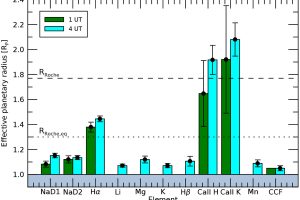Chemical composition and elevation of the atmosphere of WASP-121b. The study: “Atmospheric Rossiter-McLaughlin effect and transmission spectroscopy of WASP-121b with ESPRESSO” of F. Borsa (INAF-OA Brera) recently appeared on A&A)

Ultra-hot Jupiters are gaseous planets orbiting at close distances from their central stars, with rotation periods shorter than 3 days. Their atmospheres are thus heated, more than 2000 degrees, by the incident radiation emitted by the central star. For this reason, the atmospheres of ultra-hot Jupiters shows peculiar properties compared with planets of other types. For instance, they are affected by important mass-loss due to photo-evaporation, they typically do not host molecules, and the heavy elements such as Iron are in the gaseous phase.
The atmospheres of these planets are studied with spectroscopic observations at high resolution taken during both the primary transit (when the planet transit in front of the star) and the secondary transit (when the planet is transiting behind the star). These observations allow the astronomers to study the properties and chemistry of the atmospheres. Besides, if the spectra are taken as part of a long series of observations which properly samples the phase of the planetary orbit, they allow to study the orbit with the method of the radial velocity (e.g., by detecting the oscillations of the star around the common center of mass of the planet-star system due to the orbit of the planet). However, astronomers must account for effects that can affect these measurements, in particular the spectroscopic signatures of the magnetic activity of the star and the effects due to stellar rotation (e.g. an apparent deviation from the Keplerian orbit motion due instead of effects induced by stellar rotation on the observed spectra, named “Rossiter-McLaughlin effects”).
The team led by the astronomer F. Borsa, INAF – Astronomical Observatory of Brera, had analyzed spectroscopic observations of the ultra-hot Jupiter WASP-121b taken during transits with the spectrograph ESPRESSO mounted on the Very Large Telescope of the European Southern Observatory. WASP-121b is a planet with 1.2 Jupiter masses and a radius of 1.7 Jupiter radii, orbiting around a F6 star (1.38 solar masses) with a period of 1.27 days. After accounting for the Rossiter-McLaughlin effect and stellar activity, the authors have identified several chemical elements in the atmosphere of the planet, such as Sodium, Lithium (detected for the first time in the atmosphere of an exoplanet), Magnesium, Potassium, Iron (both neutral and ionized), Crome, and Calcium. These observations have also confirmed the presence of an extended atmosphere around the planet, with different chemical elements stratified at different heights. Besides, observations have detected intense vertical winds. The study is described in the paper: “Atmospheric Rossiter–McLaughlin effect and transmission spectroscopy of WASP-121b with ESPRESSO“, recently appeared on Astronomy & Astrophysics. The astronomer G. Micela, INAF – Astronomical Observatory of Palermo, is a coauthor of the paper.
The figure (click here to visualize the entire image) shows how the apparent radius of WASP-121b changes when it is derived from spectral lines of different chemical elements. This is an effect of the stratification of the chemical elements at different heights. It is also shown the height of the Roche lobe, e.g. the distance at which gas is gravitationally bound with the planet.
Mario Giuseppe Guarcello ( follow mguarce)
